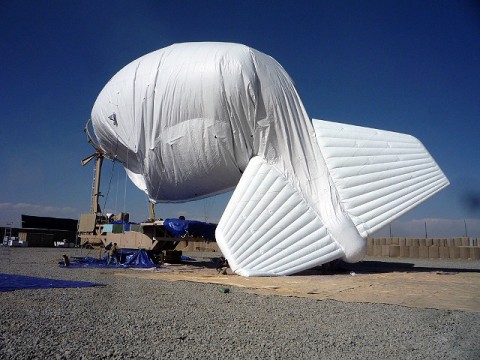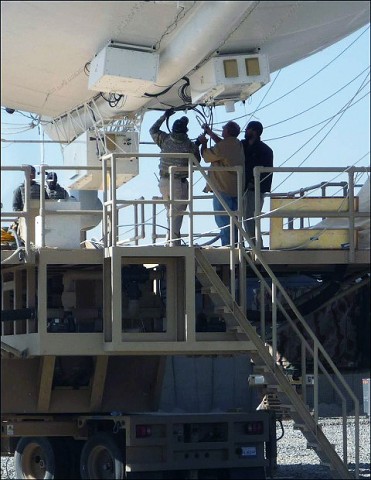Written by U.S. Army 1st Lt. R.J. Peek
Task Force Rakkasan Public Affairs

 Ghazni Province, Afghanistan – Task Force Iron Rakkasan launched the first flight of the blimp over Forward Operating Base Andar November 17th.
Ghazni Province, Afghanistan – Task Force Iron Rakkasan launched the first flight of the blimp over Forward Operating Base Andar November 17th.
The blimp, properly known as a Persistent Threat Detection System, allows a 360 degree, all-weather, birds’-eye view of the surrounding area, with very little restrictions.
The PTDS, a Lockheed Martin system, requires two people to operate it at any given time. Alfred Henderson, a PTDS crew member from Portsmouth, VA, specializes in the maintenance of the system’s platform but, like all of the operators, is well trained on the entire system.

“Lockheed Martin ensures everyone working with the PTDS has a lot of experience and versatility,” said Henderson. “Each operator is fully capable of operating this system, as well as handling the difficulties that come with living and working in a combat area.”
The “eye in the sky” has proven to be a great asset to the American Soldiers in Afghanistan. The operators are able to watch the Soldiers on patrols and provide them with a view they would otherwise lack. Viewing the area from above eliminates the enemy’s ability to hide behind a wall or in a ditch.
 The blimp has the ability to view the area using three different camera views, as well as seeing at night and during bad weather. “The camera lets us … see more than the enemy wants us to see,” one of the operators said.
The blimp has the ability to view the area using three different camera views, as well as seeing at night and during bad weather. “The camera lets us … see more than the enemy wants us to see,” one of the operators said.
Insurgents in Andar District seem to be quite aware of the impact the new blimp will have. Almost immediately after the blimp took flight, insurgents unsuccessfully attempted to shoot it down.
PTDS system operations Michael Baumgartner from Crestview, FL, and Robert McGuire from Warner Robins, GA, both served previously in the Air Force.
“This is a great way for us to continue to serve our country,” Baumgartner said. “We can help the Soldiers to be more effective on the battlefield and perhaps even help to save a life. Any job that supports the troops is worth working hard for.”
“We look forward to increasing the security bubble in Andar District with the help of the blimp,” said U.S. Army Lt. Col. David Fivecoat from Delaware, OH, commander of 3rd Battalion, 187th Infantry (Task Force Iron), 3rd Brigade Combat Team, 101st Airborne Division. “The insurgents will have a hard time hiding when the PTDS is up and watching.”


